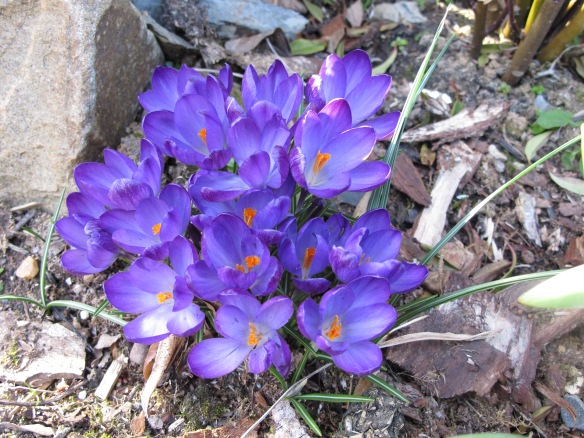Britain and the United States have a special relationship, and in the interest of strengthening it I’m offering you a brownie recipe. Recipes not only build intercultural understanding, they’re entirely noncaloric. Even if we never try them–and let’s face it, most of us don’t–reading them fills us with an unreasonable hum of calorie-free happiness.
And since this is a calorie-free post, we’ll go for the richest one in my considerable stash of brownie recipes.
But before I go on, a word about the special relationship: The thing that makes it so special is that Britain knows what it is and the U.S. doesn’t. In Britain, it’s known as the special relationship. In the U.S., it’s known as um, what?
It’s a bit like one person being in a marriage and the other one not. You don’t get more special than that.
But it does mean that the two countries really could understand each other better. So let’s not start with the hard stuff, like whether we’re talking about a relationship, a quick fling, or an open marriage. Let’s start with food, because everybody needs to eat.
By way of unnecessary background, brownies are (a) American and (b) much admired in Britain. The village I live in has an underground economy that runs on favors and I negotiate my way through it (mostly) in brownies. I know, I’m reinforcing a stereotype and I shouldn’t, but it’s so easy this way.
Brownies are also (c) much misunderstood in Britain, where you can call anything edible, rectangular, and brown a brownie. Then you can hide it under ice cream, whipped cream, and chocolate sauce and no one will think it’s strange. Or–with all that stuff running interference–notice what the brownie itself tastes like.
Or be sure it’s there at all.
Having said that, the recipe that I promise I’ll get around to eventually is British and comes to you by way of a beachside cafe in Trebarwith Strand. The place has, tragically, changed hands, but before that happened it sold a fantastic brownie, which didn’t come buried under a bunch of irrelevant foodstuffs.
And what’s better, it sold a booklet with a handful of recipes, from which I’ve taken this.
By way of further unnecessary background, the only part of a recipe that can be copyrighted (she said defensively) is the way it’s written. The proportions and methods? Can’t be done. So this is fair game.
Being British means the recipe’s metric. So if you’re in the U.S. of we-use-cup-measurements A., sorry, sorry, and sorry. Over here in the Olde Worlde, you weigh your ingredients. In milllithingies, which are more reliable than using cups and liquid ounces because they stay the same from country to country, which cups and so forth don’t.
I’d translate the millithingies for you, but you don’t want a recipe where I’ve been turned loose with the numbers. Really, you don’t. Lord Google can manage it for you if you feed him the millithingies one by one.
The recipe doesn’t include whipped cream, chocolate sauce, or chopped broccoli to top the brownie. It doesn’t even have frosting. Good brownies don’t need frosting. So the brownies this makes won’t be beautiful, but they will be good.
Trebarwtih Brownies
200 grams butter (salted, unsalted, deep fried, whatever you’ve got)
350 grams dark chocolate (in Britain, 70%; in the U.S., never mind; settle for dark)
250 grams dark brown sugar (or light brown; I can’t be bothered keeping both on hand)
3 eggs
1 tsp. baking powder
70 grams flour ( in Britain, that’s plain flour)
Melt the butter and chocolate together over a low heat. Beat the eggs and the sugar together and stir them into the melted chocolate mix. Sift the flour and baking powder together–or if you’re as lazy a cook as I am, just whisk them together. I can’t tell the difference. Stir them into everything else.
Oil a square pan and line it with baking paper or greaseproof paper, which may or may not be the same thing but do the same job. If you cut the paper so it overlaps the pan on two sides, you’ll be able to lift the brownies out neatly. If you don’t line the pan, you’ll end up with some delicious brownie hash. Which is not to be confused with hash brownies.
Scrape the batter into the pan. Lick the scraper. Do not, under any circumstances, share.
Bake at 160 C. if you have a fan oven or 180 C. if you have a regular one, or 350 F. if you’re in the U.S., which doesn’t speak Centigrade. Depending on the size of your pan, bake for somewhere between 40 minutes and an hour. My pan’s 8 ¼ inches (21 cm) square and the time leans toward a full hour. Stick a knife into the center to see if it’s done. If the middle’s set or just a bit gooey, that’s fine. If it’s disgusting, that’s not so fine: Stick it back in the oven.
I know. I used to count on recipes being exact–or at least pretending to be exact. When they didn’t work out the way they were supposed to, it was reassuring to think that someone somewhere was certain and any changes were my fault.
Any changes aren’t your fault. Either they’re mine or that’s just how life is. Or how baking is. But we’ve already agreed that you don’t have to actually bake these. Baking is what causes calories.
Does our relationship feel more special now?





